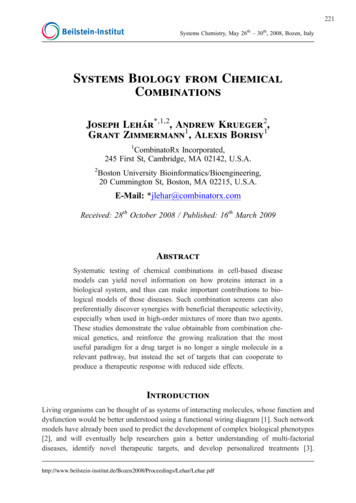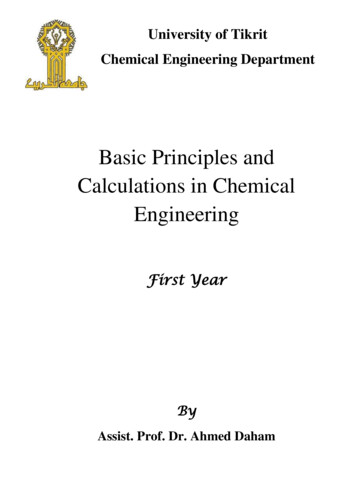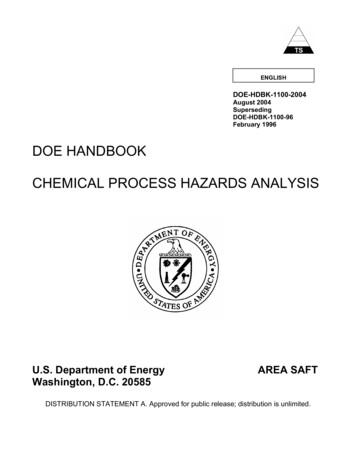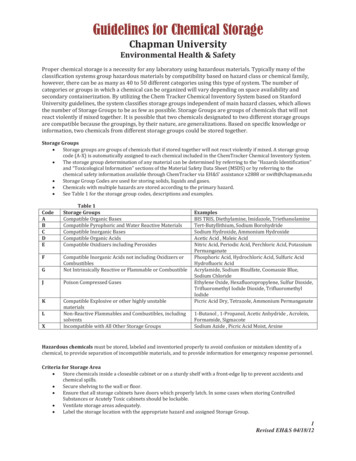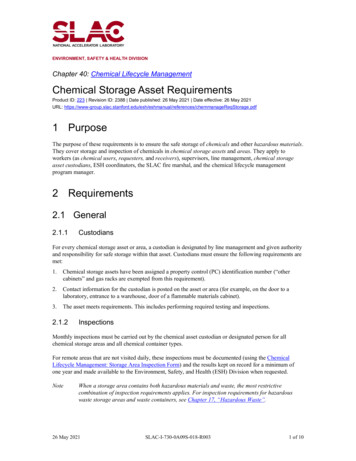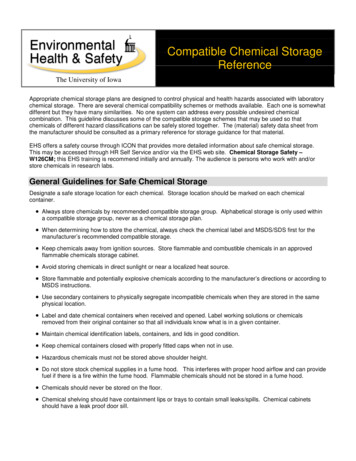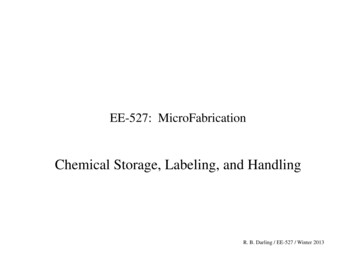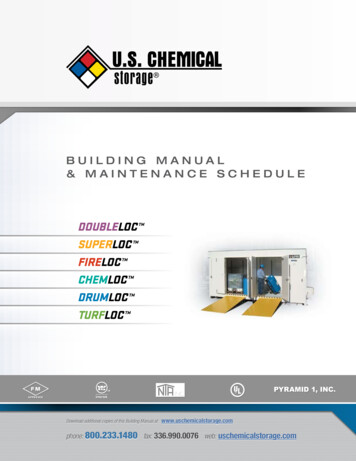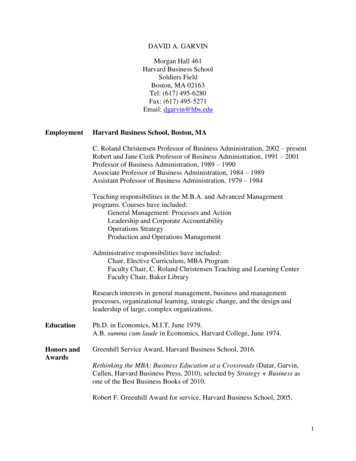
Transcription
Chapter 6: How Cells GrowDavid ShonnardDepartment of Chemical EngineeringMichigan Technological UniversityDavid R. ShonnardMichigan Technological University1Presentation Outline: Introduction Batch Growth CharacteristicsGrowth Stages, Effects of Environmental Conditions,Product Formation, Mathematical Models Continuous Growth CharacteristicsDilution Rate, Optimum OperationDavid R. ShonnardMichigan Technological University21
IntroductionCell growth is the primary response of viable cells tosubstrates and nutrients.Substrates/nutrients cells products more cells1 dXX dtX cell mass concentration (g / L)t time (h)specific growth rate (h -1), µ Product formation is a secondary response.David R. ShonnardMichigan Technological University3Determining Cell Concentration1. Cell number concentrationa) hemocytometer (Petroff-Hausser slide)b) viable cell counts (petri dish)c) electronic particle counter“Bioprocess Engineering: Basic ConceptsShuler and Kargi, Prentice Hall, 2002David R. ShonnardMichigan Technological University42
Determining Cell Concentration (cont.)2. Cell mass concentrationa) direct methods dry weight (filtration or centrifugation) packed cell volume (centrifugation) optical density (light scattering, 600-700 nm)David R. Shonnard5Michigan Technological UniversityDetermining Cell Concentration (cont.)2. Cell mass concentration (cont.)a) indirect methods measure biomolecule concentration and correlate to drycell mass concentration.(DNA, protein, ATP, NADH, product formation)Example 1. NH4 utilization during growth releases H , amountof OH- added is proportional to growth.Example 2. Luciferin O2 ATPDavid R. ShonnardlightluciferaseMichigan Technological University63
Batch Growth CurveInoculum [Xo][So]growth medium (substrate nutrients)BatchReactorX cellConcentration(cells/mL)“Bioprocess Engineering: Basic ConceptsShuler and Kargi, Prentice Hall, 2002David R. ShonnardMichigan Technological University7Lag Phase no increase in cell numbers induction of enzymes to utilized substrate(s) very important to decrease lag period to productivityi. Inoculate with exponential phase cellsii. Pre-acclimate inoculum in growth mediaiii. Use high cell inoculum size (5-10% by volume)David R. ShonnardMichigan Technological University84
Exponential Growth Phase1. Nutrient and substrate concentrations are large2. Growth rate is independent of nutrient and substrate conc.3. Cell number and mass concentrations increase exponentiallydX µmax X, X X o at t 0dtXµtX Xoe max or ln µmax tXodoubling time of cells (t d ),td ln 2µmaxorµ max lnoXXooooSlope µmaxtX 2 ln(2) µmax t dXoln 2td4. Balanced growth occurs cell composition constantDavid R. ShonnardMichigan Technological University9Deceleration Phase depletion of one or more nutrients accumulation of toxic byproducts of growth unbalanced growth and metabolism shifts for survivalDavid R. ShonnardMichigan Technological University105
Stationary Phase no net growth of cell numbers or cell mass (no cell division) cell growth rate cell death rate secondary metabolites (products) produced endogenous metabolism of energy stores can result inmaintaining cell viability removal of inhibitory compounds will result in further growthif additional substrate is providedDavid R. ShonnardMichigan Technological University11Death Phase1. Cell lysis (spillage) may occur2. Rate of cell decline is first-orderdX - kd’ t, X X S at t 0dt’XX XS e -kd t or ln - kd’ tXo3. Growth can be re-established by transferring to fresh mediaDavid R. ShonnardMichigan Technological University126
Effects of Temperature on Cell Growthµmax doubles for each 10Û& LQFUHDVH QHDU Topt( µmax - kd )’µmax A e -E a / RT andk’d A ’e-E d / RTE a activation energy for growth 10 to 20 kcal / moleE d activation energy for death 60 to 80 kcal / moleAs T , kd’ faster than µmax, (µmax- kd’) “Bioprocess Engineering: Basic Concepts, Shuler and Kargi, Prentice Hall, 2002David R. ShonnardMichigan Technological University13pH Effects acceptable pH is 1 to 2 pH units pH range varies by organismbacteria (most) pH 3 to 8yeastpH 3 to 6plantspH 5 to 6animalspH 6.5 to 7.5 microorganism have the ability to control pH inside the cell,but this requires maintainance energy pH can change due to utilization of substrates; NH4 releases H , NO3- consumes H production of organic acids, amino acids, CO2, basesDavid R. ShonnardMichigan Technological University147
pH Effects (cont.)“Bioprocess Engineering: Basic ConceptsShuler and Kargi, Prentice Hall, 2002David R. ShonnardMichigan Technological University15Dissolved O2 Effects O2 may be a limiting substrate for aerobic fermentation,since O2 is sparingly soluble in water critical O2 concentration5 to 10% of saturation (§ 7 mg O2/L) for bacteria/yeast growth exhibits saturation kinetics with respect to O2concentration (see next page)David R. ShonnardMichigan Technological University168
Dissolved O2 Effects (cont.)Saturation kineticsObligate aerobic cellsSaturation kineticsFacultativeaerobiccellsµ* µ - µ anaerobicmaxanaerobicµ- µmaxaerobicmax“Bioprocess Engineering: Basic ConceptsShuler and Kargi, Prentice Hall, 2002David R. ShonnardMichigan Technological University17Other Effects on Cell Growth dissolved CO2 (DCO2); to high or low DCO2 is toxic ionic strength (I); too high dissolved salts is inhibitory tomembrane function (membrane transport of nutrients, osmoticpressure)I 1/2 Σ Ci Zi2Ci molar concentration of ion iZi ion charge maximum non-inhibitory concentrations of substrates, productsglucose (100 g/L), ethanol (10 g/L), NH4 (5 g/L), .David R. ShonnardMichigan Technological University189
Stoichiometric Coefficients for GrowthYield coefficients, Y, are defined based on the amount ofconsumption of another materialYX/ S -Growth Yield X S S Sassimilated Sassimilated Sgrowth energy Smaintenanceinto biomassintoextracellularproductsenergyBecause S changes with growth condition, YX/S is not a constantDavid R. ShonnardMichigan Technological University19Stoichiometric Coefficients for Growth (cont.)Typical range of yield coefficientsGrowth YieldYX/ S - X SYX/S 0.4 to 0.6 g dry cells/g substrate consumedYX/S, oxidized S (0.4 to 0.6 ) YX/S, reduced S (0.6 to 1.0)Other Yield Coefficients:YX/ O2 - X O2YX/O2, reduced S (0.15 to 0.3 ) YX/ O2, oxidized S (0.3 to 1.5)David R. ShonnardMichigan Technological University2010
Stoichiometric Coefficients for Growth (cont.)Other Yield Coefficients:YX/ ATP Xg dry cells() ATP mole ATP generatedYX/ATP complex medium (a.a.s and nucleic acids available)YX/ATP minimal medium (only inorganic salts and substrate)Anaerobic Fermentations:YX/ATP § 10.5 2 (g dry cell wt./mole ATP)C6H6O6 2 C2H5OH 2 CO2: 2 moles ATP/mole glucoseYX/S § YX/ATP (2)/MW glu (10.5)(2)/180 0.12 g dcw/g glucoseDavid R. ShonnardMichigan Technological University21Product Yield Coefficients1. Growth associated products: products appear simultaneouslywith cells in cultureqP 1 dP YP/ X µX dt2. Non-growth associated products: products appear duringstationary phase of batch growthqP β3. Mixed-growth associated products: products appear duringslow growth and stationary phaseDavid R. ShonnardqP α µ βMichigan Technological University2211
Product Yield Coefficients (cont.)1. qP 1 dP YP/ X µX dt3. qP α µ β2. qP β“Bioprocess Engineering: Basic ConceptsShuler and Kargi, Prentice Hall, 2002David R. Shonnard23Michigan Technological UniversityHeat Generation by GrowthOnly 40 to 50% of the energy stored in a carbon substrate is convertedto biological energy (ATP) during aerobic metabolism. Theremainder is released as heat upon conversion to CO2 and H2OEnergy Balance:Substrate O2 I1/YH(kJ/g dcw)I Energy Released Total Available by Growth Energy of Substrate Combustion HS (kJ/g S)II Energy Available in Biomass IIICO2 H2OIICO2 H2O CellsDavid R. ShonnardIIICombustion of Cells HC (kJ/g dcw)Michigan Technological University2412
Heat Generation by Growth (cont.)On a per gram of substrate basis(1 g S) HS (1 g S) YX/S/YH (1 g S) YX/S HCSolving for YHYH YX / S( HS - YX / S HC )Typical HC 20 to 25 kJ/g dcwDavid R. Shonnard25Michigan Technological UniversityHeat Generation by Growth (cont.)For Substrates:SGlucoseMethanolEthanoln-DecaneMethane HS (kJ/g S)YH (g 380.015The oxidation state of S has a large effect on 1/ YHDavid R. ShonnardMichigan Technological University2613
Rate of Heat Generation by Growth, QGrQ Gr VL µX1 kJ( )YH hrCell Mass ConcentrationLiquid VolumeSpecific Growth Rate of CellsHeat can be removed by circulating cooling water through anexternal jacket around the reactor vessel or through a coiled tubewithin the reactor.David R. ShonnardMichigan Technological University27Modeling Cell GrowthStructured Models:Model divides cell mass into components (by molecule or by element)and predicts how these components change as a result of growth.These models are very complex and not used very often.Unstructured Models:Model assumes balanced growth where cell components do notchange with time. Much less complex and much more commonlyused. Valid for batch growth during exponential growth stage andalso for continuous culture during steady-state operation.David R. ShonnardMichigan Technological University2814
Monod EquationSimilar to Michaelis-Menten KineticsAssumes that a single enzyme system is responsible for the uptake ofsubstrate (S), and that S is limited (growth-dependent variable).This is the most common kinetic model for cell growth.µ µm SKS Sµ specific cell growth rate (hr-1)µm maximum specific cell growth rate (hr-1)S substrate concentration (g/L)KS Saturation constant (g/L) S when µ 1/2 µm.David R. ShonnardMichigan Technological University29Batch Culture Growth Modelµ 1 dXµm S X dtKS SWe relate changes in S to changes in X through YX/SX - Xo YX/S (So - S), orS So Xo/ YX/S - X/ YX/SYX/S cell mass yield (g dcw/g S consumed)Xo, So initial concentrations of cells and substrateµ m (SoYX /S X o - X)dX Xdt(K SYX /S SoYX / S Xo - X)David R. Shonnard;at t 0, X XoMichigan Technological University3015
Batch Culture Growth Model (cont.)Logistic EquationKSYX /S(K SYX /S SoYX / S Xo ) X ln ln {(SoYX / S X o - X)So YX /S } µm t Xo (So YX /S Xo )(So YX /S Xo )“Bioprocess Engineering: Basic Concepts, Shuler and Kargi, Prentice Hall, 2002David R. Shonnard31Michigan Technological UniversityBatch Growth Data and Monod ParametersThough the Logistic Equation qualitatively predicts the shape of batchgrowth, it is not very useful when attempting to determine KS andµmax from X versus time data.Xo YX/S SoKS is determined differently.KS is equal to S when µ 1/2 µmaxoooXlnXoooSlope µmaxo otµ 1/X dX/dt needs to bedetermined from availabledata, especially data at lowS concentrations.µmax“Bioprocess Engineering: Basic ConceptsShuler and Kargi, Prentice Hall, 2002David R. Shonnardooooo1 dXµ X dtoµ 1/2 µmaxoKSMichigan Technological UniversityS3216
6.4 Cell Growth in Continuous CultureAutomated Chemostats control ofpH, temp.agitation,dissolvedoxygen sterilizationrequired“Bioprocess Engineering: Basic ConceptsShuler and Kargi, Prentice Hall, 2002David R. ShonnardMichigan Technological University33Chemostat as a Tool evaluate KS, µmax, YX/S and other system parameters study changes in environment and effects on cell physiology select for cells with desired metabolic capabilities (e.g. selectionfor cells capable of degrading a toxic compound)David R. ShonnardMichigan Technological University3417
Chemostat Mass BalanceWhy derive mass balance equation?1. Describe dynamics of cell growth, substrate utilization, andproduct formation.2. Useful for control of bioreactors.3. Evaluate kinetic and yield parameters.4. Determine the optimum values for bioreactor operatingparameters.David R. ShonnardMichigan Technological University35Ideal Constant-Stirred Tank Reactor Chemostat“Bioprocess Engineering: Basic ConceptsShuler and Kargi, Prentice Hall, 2002David R. ShonnardMichigan Technological University3618
Mass Balance Statement for Cell Mass mass rate of cell mass rate mass rate growth without of cells into - of cells out endogenous bioreactor of bioreactor metabolismor mass rate mass rate of cell loss of cells - by endogenous accumulation metabolism in bioreactor FXo - FX VR µX - VR kd X VR dXdtF in and out volumetric flow rate (L / hr)X bioreactor and outlet cell mass concentration (g / L)Xo inlet cell mass concentration (g / L)µ specific cell growth rate neglecting endogenous metabolism (hr-1)k d endogenous cell loss rate constant (hr-1)David R. ShonnardMichigan Technological University37Steady-State and Sterile FeedChemostats are normally operated at steady-state, d/X/dt 0.Assume a sterile feed (Xo 0), and kd is so small that isneglected, kd 0.The cell mass balance equations becomes, mass rate of cell mass rate growth without of cells out endogenous of bioreactor metabolismorFX VRµXDavid R. Shonnard F µ or D µVRFwhere D, dilution rateVRMichigan Technological University3819
Substrate ConcentrationUsing the Monod Equation, we can predict the bioreactor andoutlet stream concentration of Substrate.µ µ max S DKS Srearranging,David R. ShonnardS KS Dµ max - DMichigan Technological University39Bioreactor “Washout” ConditionThere is an upper limit on D, or the cells will washed out of thebioreactor.D David R. Shonnardµmax SoK S SoMichigan Technological University4020
With Endogenous MetabolismIf endogenous metabolism is considered, it is left as an exercisefor the students to show that (for kd 0) D µ - kdandS Why is S higher thanthe case when kd 0?KS (D kd )µmax - D - kdDavid R. ShonnardAnswer: X is lower!41Michigan Technological UniversityCell ConcentrationHow is X affected by D? A similar mass balance equation for Sin the absence of endogenous metabolism is written to answerthis question.FSo - FS - VR µX 1M - VR q p X 1 VR dSYX / SYP /SdtS bioreactor and outlet substrate concentration (g / L)So inlet substrate concentration (g/ L)YXM/S maximum cell yield coefficient (g cells / g substrate)YP/ S product yield coefficient (g product / g substrate) gP g cells hr q p specific rate of extracellular product formation David R. ShonnardMichigan Technological University4221
Cell Concentration (cont.)For the simple case of no product formation (qp 0), steady-state(dS/dt 0), and no endogenous metabolism, kd 0.D(So - S) µXYXM/Sat steady -state, µ D, and solving for X,M (S - S)X YX/SoorKS DM (S X YX/S)oµmax - DDavid R. Shonnard43Michigan Technological UniversityEffects of Endogenous MetabolismThus far, the substrate balance eqn. Has been written assumingMthat YX/S is a constant at YX / S .(D k )D (So - S) XdMYX/S 0With endogenous metabolism,rearranging,µ D kdkdand with no extracellular product D (So - S) - D MM 0XYYX/SX/Sformation, the substrate massandbalance is at steady-state,wherekdmS MYX /Smaintenance coefficientbased on S.David R. ShonnardD - D - kd 0MYXM/SYXAP/S YX/S1 1 mS 0DY APYMX /SX/SMichigan Technological University4422
Measurement of Maximum Cell Yield andMaintenance using a ChemostatFrom measurements of X, S, So, and D in a chemostatexperiment at different D values, a double reciprocal plot can bemade.withmS kdMYX /SMkd mSYX /SM“Bioprocess Engineering: Basic ConceptsShuler and Kargi, Prentice Hall, 2002David R. Shonnard45Michigan Technological UniversityUsing a Chemostat to Determine µmax and KSFrom data collected using a chemostat, we can obtain theMonod Equation kinetic parameters.Data include S at several Dilution Rates (D),Recall that,D µ kdooµmax SD kdKS S1D kdrearranging1D kd 1µ maxDavid R. Shonnard slope KSµ maxintercept 1µ maxooKS 1µmax SMichigan Technological University1S4623
Productivity of a ChemostatPrX productivity for cell production DXPrP productivity for product formation DPThe dilution rate (D) which maximizes productivity is found bytaking dPr/dD 0 and solving for D (Doptimum).For example, Doptimum for X with kd 0 and qP 0X YXM/ S (So KS D)µmax - D DX YXM/S D(So KS D)µ max - Dtake d(DX) 0 and solve for D (D opt )dDDopt µmax (1 -KS)K S SoDavid R. ShonnardKS is usually Sso Dopt µmax (washout point)Michigan Technological University47Product Mass BalancedPdtat steady - state, dP / dt 0 and for Po 0q XDP q PX or P PDFPo - FP VRq PX VRfor kd 0, no endogenous metabolismS KS Dfrom X mass balanceµmax - DX YXM/S (So - S)D(D q PDavid R. ShonnardYXM/ S)YP/ Sfrom S mass balanceMichigan Technological University4824
Product Mass Balancefor kd 0, with endogenous metabolismKS (D kd )from X mass balance( µmax - D- kd )DX YXM/S (So - S)from S mass balanceYM(D kd q P X /S )YP /SS to determine D for optimum P formation,d(DP) 0dD David R. Shonnardsolve for Dopt49Michigan Technological UniversityA Summary of Chemostat Response to DSoXConc. ofX or SDoptDX (g/L hr)D (hr-1)David R. ShonnardMichigan Technological Universitywashout atµ max SoD KS So5025
maintenance energy 20 David R. Shonnard Michigan Technological University Stoichiometric Coefficients for Growth (cont.) Typical range of yield coefficients Growth Yield Y X/S 0.4 to 0.6 g dry cells/g substrate consumed Y X/S, oxidized S(0.4 to 0.6 ) Y X/S, reduced S(0.6 to 1.0) Other Yield


